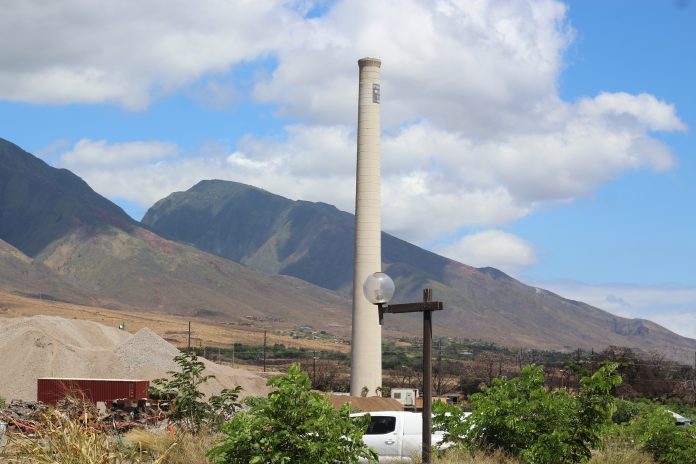By Yiming Fu, Report for America corps member
Cheryl Bautista Hotta grew up on the Pioneer Mill Sugar Co. plantation behind Lahaina’s smokestack known as Mill Camp or Kuhua Village. Hotta, who is Kanaka Maoli and Filipino, lived on Kopili Street with her parents and seven siblings in a two-bedroom house. She has fond memories picking plum and tamarind and washing laundry with her grandmother Helen in the nearby Kahoma stream.
The smoke looked like a bomb going off as it came out of the stack, Hotta said, and the wind blew black streaks across the sky. Hotta passed through the mill yard on her ten-minute walk to the Sacred Hearts school, which was more of a run because she was afraid of the cane trucks.
“We had to pass the welding and the banging and these big trucks. As a little person with all this machinery going on when we had to walk to school, it was kind of terrifying,” Hotta, who grew up on the plantation in 1955 to the 1990’s, said. Over time, Hotta got used to the sight and smell of the smokestack because it was a part of her daily life.
On July 22, the County of Maui Department of Public Works found cracking and spalling around the smokestack’s base and closed down parts of Lahainaluna Road as a precautionary measure before further investigations. An emblem of Hawai’i’s immigrant history, the smokestack is precious to some and painful to others.
Pioneer Mill Sugar Co. built the 225-foot smokestack in 1928. It was the tallest structure on Maui at the time and became a landmark for drivers and fishermen. The mill processed 60,000 tons of sugar a year at its peak in 1960. As the sugar business busted and the sugar company closed in 1999, the mill was torn down. However, the Lahaina Restoration Foundation raised $600,000 with community support to keep the smokestack.
Theo Morrison, the executive director of the Lahaina Restoration Foundation, hopes to keep the smokestack and renovate it as needed. She said the Lahaina Restoration Foundation’s goal is to protect and preserve history of all eras of Lahaina, including pre-contact, monarchy, missionary, whaling, plantation.
Lahaina’s visible and well-preserved history is what makes it special, Morrison said, and it’s important to show all the eras of history to discuss it instead of judging it.
“We don’t pick and choose history. History happens, and we talk about it.”
The smokestack is from Lahaina’s plantation period. The sugar mills dominated Lahaina’s economy from around 1850 to 1960. Almost everyone on the island was either part of the sugar companies running the mills or recruited to work. Wealthy white plantation owners brought in Japanese, Filipino, Chinese, Portuguese and Mexican workers, looking for anyone who could do the often backbreaking labor.
The Lahaina Restoration Foundation sells bricks where people can engrave their names and have their bricks added to a circular walkway at the base of the smokestack. After the Lahaina fires, Morrison said she has seen even more demand for the bricks.
“One thing I really like about the smoke stack is walking around and reading those names. You read those names and what you get is the whole multicultural aspect of what Hawai’i is today, which is the result of the plantation, bringing in all these laborers from all these different countries.”
Before the fire, the Lahaina Restoration Foundation put in grass, walkways and two original locomotives that were used prior to trucks to bring cut sugarcane from the field into the mill. And there were plaques describing the history of these locomotives.
Joslynne Young, Hotta’s sister, wants the smokestack down because she thinks it’s dangerous. Even if it won’t fall now, she’s concerned of what could happen if it falls eventually.
“It’s a monster, it’s just a huge thing. I think the upkeep will be expensive, and when you talk about spalling concrete, that’s serious.”
While she wants the smokestack down, Young said the history must be commemorated. Her father and brother-in-laws worked the mill. Young hopes a museum dedicated to the plantation workers can replace the smokestack, perhaps with a smaller-scale replica. She wants proceeds from the museum to go back to the community, either to schoolchildren or to Lahaina people recovering from the fire.
Hotta said the smokestack represents both the Filipino and Hawaiian sides of her family history. But a museum would give a truer sense of what it was like to work and live on the plantations.

‘[The smokestack] is historical. But it’s not a cultural historical site. It has nothing to do with the Kanaka Maoli people. It has to do with the beginning of developers and investors coming over and colonizing us further. Polluting all our land. Diverting our streams. And now it’s just out of control. It needs to be pulled back and shut down. It’s dangerous, really dangerous, and has no use for our community.”
AsAmNews is published by the non-profit, Asian American Media Inc.
We are currently funded by our readers and such charitable foundations as the Robert Wood Johnson Foundation, AARP, Report for America/GroundTruth Project & Koo and Patricia Yuen of the Yuen Foundation.’
Find additional content on Bluesky, Facebook, Instagram , Tiktok, X, and YouTube. Please consider interning, joining our staff, or submitting a story, or making a tax-deductible donation.
You can make your tax-deductible donations here via credit card, debit card, Apple Pay, Google Pay, PayPal and Venmo. Stock donations and donations via DAFs are also welcomed. Contact us at info @ asamnews dot com for more info.


